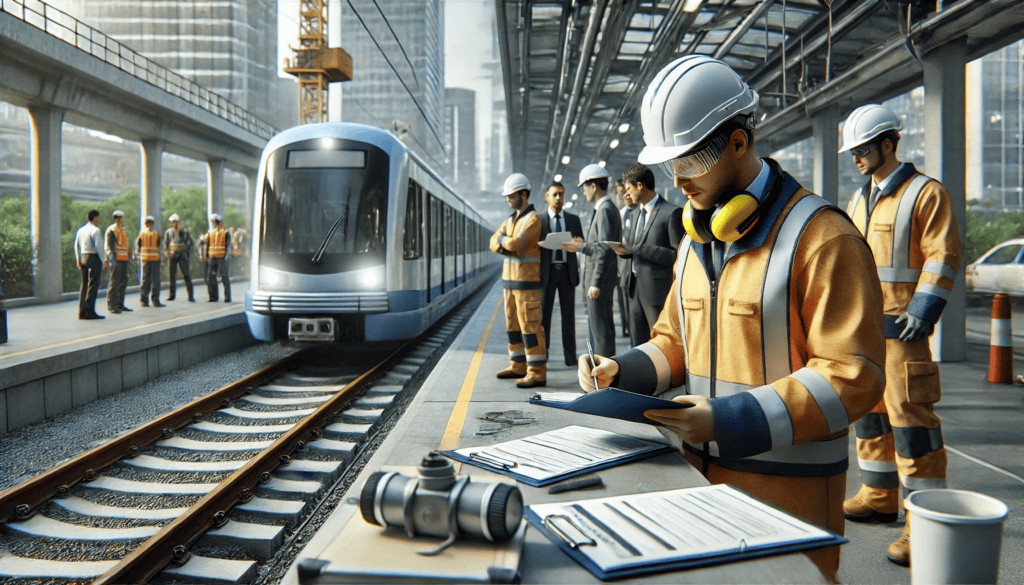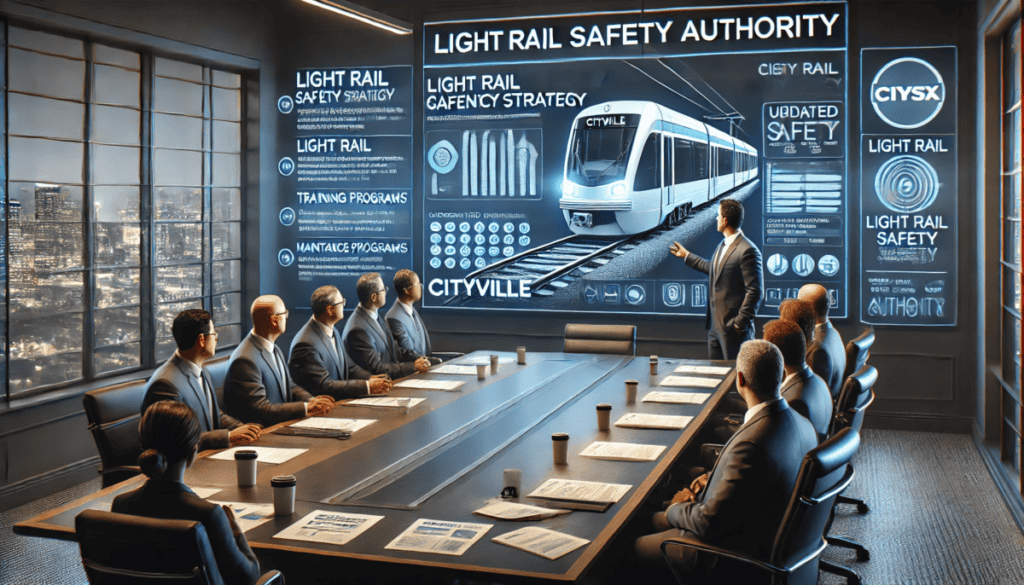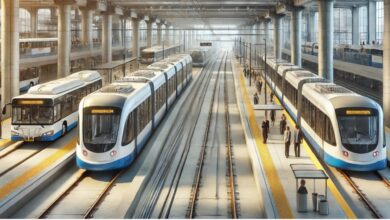Light Rail Safety Expert & Public Transit Systems

How Light Rail Safety Experts Enhance Public Transit Systems
The importance of safety in public transit systems cannot be overstated. As urban areas expand and public transit becomes increasingly essential, ensuring the safety of these systems is paramount.
Light rail systems, known for their efficiency and environmental benefits, require meticulous safety measures to protect passengers, operators, and the public. This is where the role of a light rail safety expert becomes crucial.
A light rail safety expert provides specialized knowledge and expertise to maintain and enhance the safety of light rail systems. These professionals are essential in identifying potential risks, implementing safety protocols, and ensuring compliance with regulations.
This article explores the role of light rail safety experts, the importance of safety protocols and compliance, and showcases case studies highlighting their impact.
Role of Safety Experts in Light Rail
Detailed Explanation of Responsibilities
A light rail safety expert is responsible for a wide range of tasks to maintain and improve the safety of light rail systems. These responsibilities include conducting risk assessments, performing safety audits, and developing comprehensive safety plans.
Their expertise ensures that all aspects of the light rail operation are scrutinized for potential hazards.
One of the primary roles of a light rail safety expert is to conduct thorough risk assessments. This involves identifying potential hazards that could affect the safety of passengers and operators.
They can pinpoint areas of concern by analyzing past incidents, current operational procedures, and the rail system’s physical infrastructure and develop strategies to mitigate these risks.
Key Areas of Expertise
Light rail safety experts possess specialized knowledge in several key areas:
- Risk Assessment and Management: Identifying potential risks and developing strategies to manage them.
- Safety Audits: Conduct audits to ensure safety protocols are followed and identify for improvement.
- Emergency Preparedness: Developing and implementing emergency response plans to handle incidents effectively.
- Training and Education: Training programs for operators and staff to ensure they know safety procedures and protocols.
A light rail safety expert is vital in maintaining safe operations. They work closely with other professionals, including engineers, maintenance crews, and regulatory bodies, to create a cohesive safety strategy encompassing all light rail system aspects.

Safety Protocols and Compliance
Overview of Safety Protocols
Safety protocols are the foundation of a safe light rail system. These protocols encompass various procedures and guidelines designed to prevent accidents and protect passengers and operators. They include regular maintenance schedules, safety inspections, operational guidelines, and emergency response plans.
A rail system safety consultant is critical in developing and implementing these safety protocols. They ensure that every aspect of the light rail system is covered, from the condition of the tracks and vehicles to the training of the operators. By conducting detailed safety audits and risk assessments, they can identify potential weaknesses in the system and recommend improvements.
Ensuring Compliance with Regulations
Compliance with local, state, and federal safety regulations is crucial for operating light rail systems. These regulations are designed to ensure that public transit systems operate safely and efficiently. A public transportation safety consultant helps transit authorities navigate the complex landscape of regulatory requirements.
Compliance involves regular inspections and audits to ensure all safety protocols are followed. This includes maintaining detailed records of maintenance activities, training programs, and incident reports. By ensuring compliance with regulations, light rail systems can avoid legal issues and enhance their safety standards.
Impact of Safety Consultants
The involvement of safety consultants significantly impacts the overall safety of light rail systems. Developing and implementing effective safety protocols helps prevent accidents and improve the response to incidents when they occur.
Their expertise ensures that all aspects of the light rail operation, from the physical infrastructure to the daily operational procedures, are designed with safety in mind.

Case Studies on Improved Safety
These case studies serve as theoretical examples to demonstrate potential scenarios and outcomes. While they draw on elements that could be seen in real cases, they remain entirely speculative and are used purely for educational and illustrative purposes.
Example 1: Metro City’s Safety Overhaul
Metro City faced several safety challenges with its aging light rail system. A series of incidents highlighted the need for a comprehensive safety overhaul. A light rail safety expert was brought in to conduct a thorough risk assessment and develop a new safety plan.
The expert identified several critical issues, including outdated signaling equipment, inadequate operator training, and insufficient emergency response protocols. By implementing the expert’s recommendations, Metro City addressed these issues and significantly improved the safety of its light rail system.
The result was a dramatic reduction in accidents and renewed confidence in public transit safety.
Example 2: Urbanville’s Compliance Strategy
Urbanville was struggling to comply with new federal safety regulations. The city’s transit authority hired a rail system safety consultant to help develop a compliance strategy. The consultant conducted a detailed audit of the light rail system and identified several areas of non-compliance.
The consultant developed a comprehensive plan to address these issues by working closely with the transit authority. This included updating safety protocols, enhancing training programs, and improving maintenance procedures.
The result was full compliance with federal regulations, significantly improving the light rail system’s safety.
Example 3: Safety Improvements in Railtown
Railtown experienced a serious accident that underscored the need for improved safety measures. A public transportation safety consultant was called to investigate the incident and develop a plan to prevent future accidents.
The consultant conducted a detailed analysis of the accident and identified several contributing factors, including a failure in the signaling system and insufficient safety protocols.
The consultant’s recommendations led to significant improvements in Railtown’s safety measures. These included upgrading the signaling system, implementing new safety protocols, and enhancing the operator training programs.
These improvements not only prevented future accidents but also improved the overall safety and reliability of the light rail system.

Example 4: Compliance in Cityville
Cityville faced challenges in complying with new safety regulations. The city’s transit authority hired a light rail safety expert to help develop a compliance strategy. The expert conducted a detailed audit of the light rail system and identified several areas of non-compliance.
The expert developed a comprehensive plan to address these issues by working closely with the transit authority. This included updating safety protocols, enhancing training programs, and improving maintenance procedures.
The result was full compliance with safety regulations and a significant improvement in the overall safety of the light rail system.
Example 5: Modernizing Safety Protocols in Tech City
Tech City aimed to modernize its light rail system with the latest technology. A light rail safety expert was engaged to ensure that new technological implementations would not compromise safety.
The expert extensively reviewed proposed technologies, such as automated train control systems and real-time monitoring tools, to assess their impact on safety protocols.
The expert’s analysis revealed that while these technologies had the potential to enhance operational efficiency, they required robust safety protocols to manage new risks.
Recommendations included integrating advanced monitoring systems to detect anomalies in real-time, updating operator training programs to handle new technology, and developing comprehensive emergency response strategies that included technological failures.
Implementing these recommendations allowed Tech City to modernize its light rail system while maintaining high safety standards.
Example 6: Enhancing Emergency Response in Coastal City
Coastal City, prone to natural disasters, needed to enhance its emergency response capabilities for its light rail system.
A public transportation safety consultant was hired to develop a comprehensive emergency preparedness plan. The consultant worked with local authorities to assess the risks posed by potential natural disasters, such as hurricanes and floods, and their impact on the light rail system.
The consultant’s plan included establishing emergency communication protocols, strategically placing emergency equipment, and conducting regular emergency drills involving operators and first responders.
The plan also emphasized the importance of maintaining clear and accessible evacuation routes and providing real-time information to passengers during emergencies.
Coastal City’s adoption of these measures significantly improved its ability to respond to emergencies, ensuring the safety of passengers and operators during natural disasters.

Role of a Light Rail Safety Expert
In summary, the role of a light rail safety expert is crucial in ensuring the safe operation of light rail systems. These professionals provide essential risk assessment, safety audits, and regulation compliance expertise.
Developing and implementing effective safety protocols helps prevent accidents and enhance the overall safety of public transit systems.
The involvement of safety experts significantly impacts the safety and reliability of light rail systems. Through their expertise, cities can address potential risks, improve their safety measures, and ensure compliance with regulations.
This protects passengers and operators and enhances the public’s confidence in public transit safety.

With over forty years in public transit, Timothy Borchers is a preeminent international transit and light rail expert witness specializing in accident investigation, system safety, and industry compliance. He regularly authors authoritative articles on advanced light rail topics.

